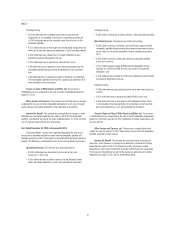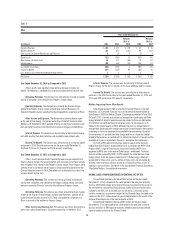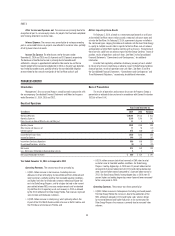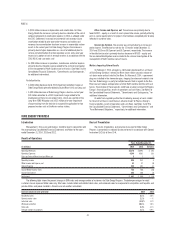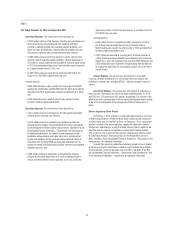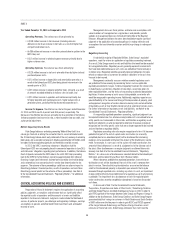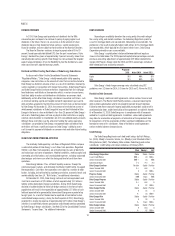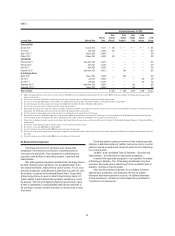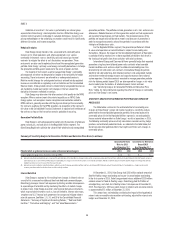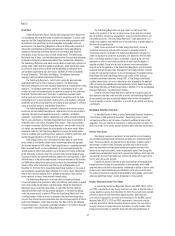Duke Energy 2014 Annual Report Download - page 67
Download and view the complete annual report
Please find page 67 of the 2014 Duke Energy annual report below. You can navigate through the pages in the report by either clicking on the pages listed below, or by using the keyword search tool below to find specific information within the annual report.
47
PART II
guaranteed fuel savings. However, if actual fuel costs are higher than expected,
Duke Energy could record a charge for the unmet guaranteed savings.
Goodwill Impairment Assessments
Duke Energy allocates goodwill to reporting units, which are determined
to be an operating segment or one level below based on how the segment is
managed. Duke Energy is required to test goodwill for impairment at the reporting
unit level at least annually and more frequently if it is more likely than not that
the fair value of a reporting unit is less than its carrying value. Duke Energy
performs its annual impairment test as of August 31.
Application of the goodwill impairment test requires management
judgment, including determining the fair value of the reporting unit, which
management estimates using a weighted combination of the income approach,
which estimates fair value based on discounted cash fl ows, and the market
approach, which estimates fair value based on market comparables within the
utility and energy industries. Signifi cant assumptions used in these fair value
analyses include discount and growth rates, future rates of return expected
to result from ongoing rate regulation, utility sector market performance and
transactions, projected operating and capital cash fl ows for Duke Energy’s
business and the fair value of debt.
Estimated future cash fl ows under the income approach are based
to a large extent on Duke Energy’s internal business plan, and adjusted as
appropriate for Duke Energy’s views of market participant assumptions. Duke
Energy’s internal business plan refl ects management’s assumptions related
to customer usage and attrition based on internal data and economic data
obtained from third-party sources, projected commodity pricing data and
potential changes in environmental regulations. The business plan assumes
the occurrence of certain events in the future, such as the outcome of future
rate fi lings, future approved rates of returns on equity, anticipated earnings/
returns related to signifi cant future capital investments, continued recovery of
cost of service, the renewal of certain contracts and the future of renewable tax
credits. Management also makes assumptions regarding operation, maintenance
and general and administrative costs based on the expected outcome of the
aforementioned events. In estimating cash fl ows, Duke Energy incorporates
expected growth rates, regulatory and economic stability, the ability to renew
contracts and other factors, into its revenue and expense forecasts.
One of the most signifi cant assumptions that Duke Energy utilizes in
determining the fair value of its reporting units under the income approach
is the discount rate applied to the estimated future cash fl ows. Management
determines the appropriate discount rate for each of its reporting units based on
the weighted average cost of capital (WACC) for each individual reporting unit.
The WACC takes into account both the after-tax cost of debt and cost of equity.
A major component of the cost of equity is the current risk-free rate on 20-year
U.S. Treasury bonds. In the 2014 impairment tests, Duke Energy considered
implied WACCs for certain peer companies in determining the appropriate WACC
rates to use in its analysis. As each reporting unit has a different risk profi le
based on the nature of its operations, including factors such as regulation, the
WACC for each reporting unit may differ. Accordingly, the WACCs were adjusted,
as appropriate, to account for company specifi c risk premiums. The discount
rates used for calculating the fair values as of August 31, 2014, for each of Duke
Energy’s domestic reporting units ranged from 5.3 to 6.9 percent.
For Duke Energy’s international operations, a country-specifi c risk
adder based on the average risk premium for each separate country in which
International Energy operates was added to the base discount rate to refl ect the
differing risk profi les. This resulted in a discount rate for the August 31, 2014
goodwill impairment test for the international operations of 10.5 percent.
The underlying assumptions and estimates are made as of a point in time.
Subsequent changes, particularly changes in the discount rates, authorized
regulated rates of return or growth rates inherent in management’s estimates of
future cash fl ows, could result in future impairment charges.
The majority of Duke Energy’s business is in environments that are either
fully or partially rate-regulated. In such environments, revenue requirements are
adjusted periodically by regulators based on factors including levels of costs,
sales volumes and costs of capital. Accordingly, Duke Energy’s regulated utilities
operate to some degree with a buffer from the direct effects, positive or negative,
of signifi cant swings in market or economic conditions. However, changes in
discount rates may have a signifi cant impact on the fair value of equity.
As of August 31, 2014, all of the reporting units’ estimated fair value of
equity exceeded the carrying value of equity by more than 10 percent.
Long-Lived Asset Impairment Assessments, Excluding Regulated Operations
Property, plant and equipment, excluding plant held for sale, is stated
at the lower of carrying value (historical cost less accumulated depreciation
and previously recorded impairments) or fair value, if impaired. Duke Energy
evaluates property, plant and equipment for impairment when events or changes
in circumstances (such as a signifi cant change in cash fl ow projections, the
determination that it is more likely than not an asset or asset group will be
sold) indicate the carrying value of such assets may not be recoverable. The
determination of whether an impairment has occurred is based on an estimate
of undiscounted future cash fl ows attributable to the assets, as compared with
their carrying value.
Performing an impairment evaluation involves a signifi cant degree of
estimation and judgment in areas such as identifying circumstances that
indicate an impairment may exist, identifying and grouping affected assets,
and developing the undiscounted future cash fl ows associated with the asset.
If an impairment has occurred, the amount of the impairment recognized is
determined by estimating the fair value of the asset and recording a loss if
the carrying value is greater than the fair value. Additionally, determining fair
value of the asset requires probability weighting future cash fl ows to refl ect
expectations about possible variations in their amounts or timing and the
selection of an appropriate discount rate. Although cash fl ow estimates are
based on relevant information available at the time the estimates are made,
estimates of future cash fl ows are, by nature, highly uncertain and may vary
signifi cantly from actual results. For assets identifi ed as held for sale, the
carrying value is compared to the estimated fair value less cost to sell to
determine if an impairment loss is required. Until the assets are disposed of,
their estimated fair value is re-evaluated when circumstances or events change.
When determining whether an asset or asset group has been impaired,
management groups assets at the lowest level that has discrete cash fl ows.
For further information related to the impairment recorded in conjunction
with planned sale of Duke Energy’s Disposal Group to Dynegy, see Note 2 to the
Consolidated Financial Statements, “Acquisition, Disposals and Sales of Other
Assets.”
Accounting for Loss Contingencies
Preparation of fi nancial statements and related disclosures require
judgments regarding the future outcome of contingent events. Duke Energy is
involved in certain legal and environmental matters arising in the normal course
of business. Estimating probable losses requires analysis of multiple forecasts
and scenarios that often depend on judgments about potential actions by third
parties, such as federal, state and local courts and other regulators. Contingent
liabilities are often resolved over long periods of time. Amounts recorded in the
consolidated fi nancial statements may differ from the actual outcome once the
contingency is resolved, which could have a material impact on future results of
operations, fi nancial position and cash fl ows of Duke Energy.
For further information, see Notes 4 and 5 to the Consolidated Financial
Statements, “Regulatory Matters” and “Commitments and Contingencies.”
Revenue Recognition
Revenues on sales of electricity and gas are recognized when either the
service is provided or the product is delivered. Operating revenues include
unbilled electric and gas revenues earned when service has been delivered
but not billed by the end of the accounting period. Unbilled retail revenues


